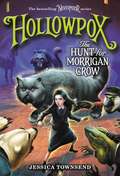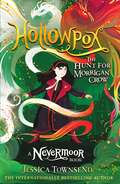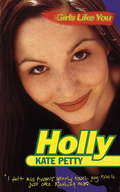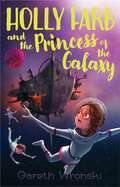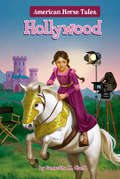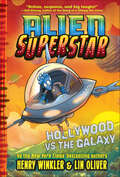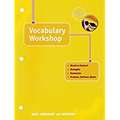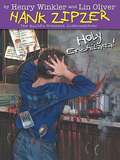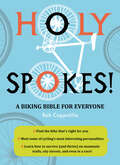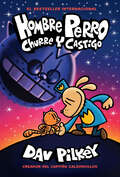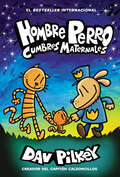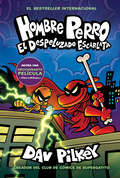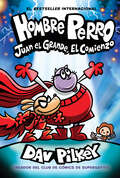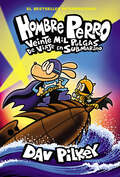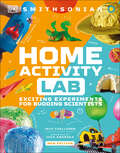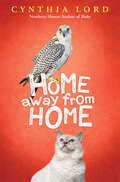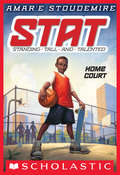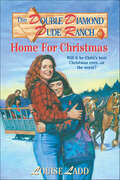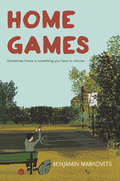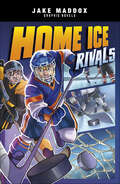- Table View
- List View
Hollow River (Fountast & Pinnell LLI Purple #Level W)
by Mike Dion Luigi AimeText Elements Genre: Fantasy/Graphic <p><p> Text Structure Narrative <p> Text Features: graphic conventions, including word, whisper, and thought balloons
Hollowpox: The Hunt For Morrigan Crow (Nevermoor #3)
by Jessica TownsendMorrigan battles a new evil as a strange, frightening illness takes hold of Nevermoor in this captivating and heart-pounding third book of the instant New York Times bestselling series.Morrigan Crow and her friends have survived their first year as proud scholars of the elite Wundrous Society, helped bring down the nefarious Ghastly Market, and proven themselves loyal to Unit 919. Now Morrigan faces a new, exciting challenge: to master the mysterious Wretched Arts, and control the power that threatens to consume her.But a strange and frightening illness has taken hold of Nevermoor, turning infected Wunimals into mindless, vicious Unnimals on the hunt. As victims of the Hollowpox multiply, panic spreads. And with the city she loves in a state of fear, Morrigan quickly realizes it's up to her to find a cure for the Hollowpox, even if it will put her -- and everyone in Nevermoor -- in more danger than she ever imagined. p.p1 {margin: 0.0px 0.0px 0.0px 0.0px; font: 13.0px Georgia} p.p2 {margin: 0.0px 0.0px 0.0px 0.0px; font: 13.0px Georgia; min-height: 15.0px} span.s1 {font-kerning: none}
Hollowpox: The Hunt for Morrigan Crow Book 3 (Nevermoor #3)
by Jessica TownsendDiscover the magical world of Nevermoor and the adventures of Morrigan Crow, in this bestselling, award-winning series for fans of Harry Potter and His Dark Materials.'Exciting, mysterious, marvellous and magical ... quite simply one of the best children's books I've read in years' Robin Stevens, author of Murder Most Unladylike.Morrigan Crow is determined, daring and ready for a new challenge: to step into her destiny as a Wundersmith, master the mysterious Wretched Arts, and control the power that threatens to consume her. She and her friends are proud to be in their second year of attendance at the magical Wundrous Society, and together they can face anything. But a strange illness has taken hold of Nevermoor, turning its peaceable Wunimals into mindless, vicious unnimals on the hunt. As victims of the Hollowpox multiply, panic spreads. And with the city she loves in a state of fear, Morrigan quickly realises it is up to her to find a cure for the Hollowpox, even if it will put her - and the rest of Nevermoor - in more danger than ever before ... Enter a world of hope and imagination in this Wundrous series, winner of the Waterstones Children's Book Prize and with film rights sold to Fox.Praise for Nevermoor: The Trials of Morrigan Crow: 'A full-speed joy of a book; funny, quick-footed, and wildly, magically inventive' Katherine Rundell, author of Rooftoppers
Holly (Girls Like You Ser. #5)
by Kate PettySand, sea and holiday romance are in store for four friends one summer.Holly is already in love with a boy she met in Barbados but will her dream last?
Holly Farb and the Princess of the Galaxy
by Gareth WronskiGuardians of the Galaxy meets Hitchhiker&’s Guide to the Galaxy in this laugh-out-loud funny journey into space and beyond!Holly Farb is not the Princess of the Galaxy. She may be top of the class in every subject, but she can&’t even win a school election, never mind rule the Milky Way. The aliens who kidnapped her have gotten it all wrong. Unfortunately Holly&’s alien pirate kidnappers believe that she&’s the princess they&’ve been looking for, and so she finds herself hurtling through space on an alien pirate ship together with her teacher, Mr. Mendez, and Chester, the most annoying boy in her class. Now all she has to do is escape the pirates, find the missing princess, and get back to Earth in time for her big test on Friday. But it turns out that space is a pretty big place, and before they can go home, Holly, Chester, and Mr. Mendez must face down space cruise liners, bounty hunters, giant worms, perky holograms, cosmic board games, sinister insectoid librarians, and a robot who is learning how to lie. Between running from space pirates, defying the President of the Universe, and meeting a host of rather unusual new friends, Holly starts to wonder if there might be more to life than being top of the class after all.
Holly, Reindeer, and Colored Lights: The Story of the Christmas Symbols
by Edna Barth"Holly and Reindeer, angels and stars, trees sparkling with colored lights. Weeks before Christmas, these and other holiday symbols appear all around us. Each of the symbols has a story. Many of them go back to the first Christmas or long before. And each of them has a special meaning for us today." Contains suggested reading and an index. Traces the origins of our favorite holiday customs and symbols, many of which antedate the first Christmas. Find out more about your favorite holidays. There are four more fascinating books by Edna Barth in the Bookshare collection. Try, Witches, Pumpkins, and Grinning Ghosts: The Story of the Halloween Symbols,Turkeys, Pilgrims, and Indian Corn: The Story of the Thanksgiving Symbols, Hearts, Cupids, and Red Roses: The Story of the Valentine Symbols, Shamrocks, Harps and Shillelaghs: The Story of the St. Patrick's Day, Lilies, Rabbits, and Painted Eggs: The Story of the Easter Symbols
Hollywood #2 (American Horse Tales #2)
by Samantha M. ClarkSet in modern-day California, this American Horse Tale is the story of a young girl who, along with her family's horse, is destined for the big screen.Juniper is a young girl who dreams of making it big in the movies along with her horse, Able. In particular, Juniper is obsessed with getting Able onto her favorite television show, Castle MacAvoy, and will do anything, even slay dragons, to make that happen. Hollywood is part of a series of books written by several authors highlighting the unique relationships between young girls and their horses.
Hollywood vs. the Galaxy (Alien Superstar)
by Henry Winkler Lin OliverHollywood vs. the Galaxy is another hilarious, action-packed intergalactic adventure in the New York Times bestselling Alien Superstar series by New York Times bestselling creators—Emmy Award–winning actor Henry Winkler and children&’s book author Lin Oliver—with illustrations by Ethan Nicolle. Buddy&’s out-of-this-world adventures continue! Since Citizen Cruel failed to capture Buddy, the Supreme Leader is left with no other choice: he must go to Earth himself to make sure Buddy is returned to his home planet for the ultimate punishment. While an unsuspecting Buddy is acting on his Hollywood sitcom, the Supreme Leader&’s powers of mind control weave a delicate web to entrap him. Will Buddy be caught? Will he succumb to these menacing powers? Will the Earthlings ever find out who Buddy Burger truly is? These are the questions that will keep readers turning pages until the end of this action-packed, side-splitting comedy adventure in the New York Times bestselling middle-grade series.
Holt Elements Of Language: Vocabulary Workshop, Fifth Course
by Holt Rinehart Winston StaffThis is a book that helps one improve their vocabulary and pronunciation knowledge.
Holy Enchilada! (Hank Zipzer, the World's Greatest Underachiever #6)
by Henry Winkler Lin Oliver Tim HeitzPS 87 is having multicultural week, and Ms. Adolf's class is putting on a "Foods from Around the World" luncheon. Hank is thrilled, no reading, no outlining, and no review questions, just cooking! Hank makes enchiladas, and at the luncheon, Ms. Adolf piles her plate with lots of food. But after a few bites, her face turns bright red. One of the dishes is super-spicy! <p>Ms. Adolf accuses someone of playing a mean practical joke, and punishes the entire class with no recess until the guilty party comes forward. Hank realizes his trouble with numbers might have caused the problem. What if he accidentally used three cups of peppers instead of 1/3 cup? Will Hank be able to get recess back for everyone without getting detention for the rest of his life? <p> <p><b>Lexile Level: 750L</b></p>
Holy Spokes!: A Biking Bible for Everyone
by Rob CoppolilloBiking is cheap, healthy, and can provide easy access into an incredible array of life experiences. In this wide-ranging and quick-hitting guide, author Rob Coppolillo explains how bikes work, why bikes matter (especially today, when gas is expensive and interest in green living is high), and how readers—whatever their level of experience—can indulge their tastes for mountain trails, competitive racing, city exploration, and basic transportation from point A to point B. Profiles from a raucous cast of health, racing, and travel experts shed light on common pitfalls and offer great ideas on pursuing your passions while on two wheels. So take the quiz, pick your bike, and let's get rolling!
Hombre Perro: Churre y castigo (Hombre Perro)
by Dav PilkeyThe mayor has had enough of Dog Man's shenanigans in the ninth book from worldwide bestselling author and artist Dav Pilkey.¡Hombre Perro ha metido la pata hasta el fondo esta vez! Tiene que entregar su placa y vaciar el escritorio, pero si bien no tiene trabajo aún le quedan esperanzas. Con sus amigos de su lado, ¿podrá Hombre Perro salir del hoyo y regresar gateando al cuerpo policial?Dog Man's really done it this time! He hands over his badge and clears out his desk, but while he may be out of a job, he's not yet out of hope. With his friends at his side, can Dog Man dig himself out of this hole and paw his way back onto the force?
Hombre Perro: Cumbres maternales (Hombre Perro)
by Dav PilkeyDog Man and Petey face their biggest challenges yet in the tenth Dog Man book from worldwide bestselling author and illustrator Dav Pilkey.A Hombre Perro se le acaba la suerte, Pedrito confronta su pasado no tan perfecto y el abuelo anda haciendo de las suyas. El mundo está fuera de control con los nuevos villanos que han llegado a la ciudad. La situación se ve oscura y sin esperanzas. Sin embargo, no todo está perdido. ¿Podrá arreglar las cosas el increíble poder del amor?Dog Man is down on his luck, Petey confronts his not so purr-fect past, and Grampa is up to no good. The world is spinning out of control as new villains spill into town. Everything seems dark and full of despair. But hope is not lost. Can the incredible power of love save the day?
Hombre Perro: El Despeluzado Escarlata (Hombre Perro)
by Dav Pilkey¡Nuestro superhéroe canino regresa en DOG MAN: THE SCARLET SHEDDER, la duodécima novela gráfica llena de suspense y divertidísima de la serie número uno en ventas mundiales del galardonado autor e ilustrador Dav Pilkey!¡Qué peste! ¡Hombre Perro ha sido rociado por un zorrillo! Tras sumergirlo en jugo de tomate el olor desaparece, pero el color rojo escarlata no se le quita. ¡Este valiente superhéroe, ahora exiliado, debe luchar para salvar a los ciudadanos que lo rechazaron! ¿El fin justificará los medios para Pedrito, quien a regañadientes regresa a la vida del crimen para ayudar a Hombre Perro? ¿Y quién dará un paso al frente cuando un villano completamente nuevo y nunca antes visto desate un ejército de robots de I.A.?Our canine superhero returns in DOG MAN: THE SCARLET SHEDDER, the suspenseful and hilarious twelfth graphic novel in the #1 worldwide bestselling series by award-winning author and illustrator Dav Pilkey!P.U.! Dog Man got sprayed by a skunk! After being dunked in tomato juice, the stink is gone but the scarlet red color remains. Now exiled, this spunky superhero must struggle to save the citizens who shunned him! Will the ends justify the means for Petey, who's reluctantly pulled back into a life of crime in order to help Dog Man? And who will step forward when an all-new, never-before-seen villain unleashes an army of A.I. robots?
Hombre Perro: Juan el Grande, el comienzo (Hombre Perro)
by Dav Pilkey¡El superhéroe favorito de todos está de vuelta en la emocionante decimotercera novela gráfica de la serie más exitosa del galardonado autor e ilustrador Dav Pilkey! Es heroico, sincero y divertidísimo: ¡es Hombre Perro!¡Sigue a Hombre Perro y a tus súper favoritos amigos mientras salvan la ciudad de un nuevo y malvado malhechor! Para aventuras de novelas gráficas más sentidas, sigue a Aleta y a Peque Pedrito en la serie El Club de Cómics de Supergatito. Y no olvides la serie que lo empezó todo: ¡El Capitán Calzoncillos!Everyone's favorite superhero is back in the thrilling thirteenth graphic novel in the #1 worldwide bestselling series by award-winning author and illustrator Dav Pilkey! It's heroic, it's heartfelt, it's hilarious -- it's Dog Man!Join Dog Man and your favorite supa buddies as they save the city from a dastardly new wrongdoer! For more heartfelt graphic novel adventures, join Flippy and Li'l Petey in the Cat Kid Comic Club series. And don't forget the series that started it all: Captain Underpants!
Hombre Perro: Veinte mil pulgas de viaje en submarino (Hombre Perro)
by Dav PilkeyDOG MAN IS BACK! The highly anticipated new graphic novel in the #1 worldwide bestselling series starring everyone's favorite canine superhero by award-winning author and illustrator Dav Pilkey!Piggy está de vuelta, y su nuevo plan es el más diabólica hasta el momento. ¿QUÉ nuevos villanos hay en el horizonte? ¿DE DÓNDE salieron? Y ¿QUIÉN dará un paso adelante para salvar a la ciudad cuando los sinvergüenzas saboteen a nuestros superamigos? Hombre Perro: Veinte mil pulgas de viaje en submarino, con sus temas de amistad y de hacer el bien, está lleno de acción y risas. Incluye un "Mordiscorama", una nueva canción, un ácaro monstruoso y ¡mucho más que antes! ¡ES HERÓICO, ES ÉPICO!Piggy has returned, and his newest plot is his most diabolical yet. WHAT other new villains are on the horizon? WHERE are they all coming from? And WHO will step forward to save the city when scoundrels sabotage our Supa Buddies? With themes of friendship and doing good, Dog Man: Twenty Thousand Fleas Under the Sea is packed with action and hilarity. Featuring "Chomp-O-Rama," a brand-new song, a monstrous Mighty Mite -- and so much more than ever before! IT'S HEROIC, IT'S EPIC!
Home
by Tracey West Style GuideWhen an alien race invades Earth, an unlikely friendship forms between Tip, a human girl, and Oh, a banished Boov in this chapter book retelling of the movie! DreamWorks' newest hit movie, Home, comes home to theaters on March 27, 2015!When Earth is taken over by the overly confident Boov--an alien race in search of a new place to call home--all humans are promptly relocated, while all Boov get busy efficiently reorganizing the planet! But when one resourceful girl, Tip, manages to avoid capture, she finds herself the accidental accomplice of a banished Boov by the name of Oh. Equally stubborn and set in their ways, these two fugitives realize there's a lot more at stake than intergalactic relations as they embark on the road trip of a lifetime. Good thing they have a flying car! DreamWorks Home © 2015 DreamWorks Animation L.L.C.
Home Activity Lab: Exciting Experiments for Budding Scientists (DK Activity Lab)
by Robert WinstonDive into science with these fun and simple experiments for children to do at home.This fun, activity-filled book is brimming with home experiments to help budding scientists aged 8-14 explore different projects. Using household items, combine science with art and craft, and make an erupting volcano, design rubber band planets, sail a soap-powered boat, and race car balloons.Packed with photography, easy-to-follow instructions, and attention to detail, Home Activity Lab will excite young scientists from the get-go! Each of the super-fun make-and-do projects in this book comes with simple step-by-step photographs and instructions that will inspire children&’s imagination and teach STEM topics.This children&’s craft book on space offers: - 28 hands-on projects that appeals to kids aged 8-14.- Materials easily found around the home with no specialist equipment needed.- Information boxes full of fascinating facts and panel stories that explain the science throughout the book.- A clear explanation how STEM is involved in creating the project or the results of the experiment.Ideal for kids who are interested in STEM, Home Activity Lab features a collection of science projects with easy-to-follow instructions and everyday ingredients that can be found around the house. Each experiment describes the science behind the project, highlighting STEM facts with STEM icons pointing out the key science, technology, engineering, and maths learning involved in each one.More in the seriesThe Activity Lab series inspires children to get hands-on with learning by creating exciting STEM projects in their favorite subject. If you liked Home Activity Lab, then why not try Dinosaur Activity Lab for budding paleontologists, Cardboard Activity Lab for eco-friendly recycling fun, Space Activity Lab for aspiring astrologists, or Great STEM Projects experiments for all budding scientists?
Home Alone
by Todd StrasserKevin's day gets off to a bad start, when his family forgets him as they go to Paris for the holidays. Then there are burglars in the neighborhood.
Home Away From Home
by Cynthia LordFrom Newbery Honor Winner Cynthia Lord, a brilliant story about how to find home when everything around us is changing.Mia and her mom visit Grandma in Maine every summer, but this year Mia is going alone. Her mom will stay behind to get their house ready to sell. It’ll be a new start, she says, after the divorce.Mia doesn’t want a new start. She’d rather everything just stayed the same! At least things will be the same at Grandma’s, though. Mia will walk to town for ice cream, and wait by the water, watching for birds, just like always.Then Mia meets Grandma’s know-it-all new neighbor, who’s just her age. Cayman acts like he belongs at Grandma’s house. He acts like he’s the expert on everything. And when he and Mia spot an unusual white bird of prey, he acts like it’s his job to find out what it is.Unless, that is, Mia finds out first. And, in her effort to prove herself to him, she makes a decision that will change things for the town, for the bird, for Cayman, and even for herself. Can Mia stop what she’s put into motion?Acclaimed author Cynthia Lord, with her trademark sensitivity, weaves her love of nature with a profound reflection on what it means to be at home in a changing world.
Home Court: Standing Tall and Talented #1) (STAT #1)
by Amar'e StoudemireSTAT: Standing Tall And Talented-- A slam-dunk new fiction series from NBA superstar Amar'e Stoudemire!Eleven-year-old Amar'e Stoudemire has a lot going on. He loves to go skateboarding in the park. He takes his school work very seriously. He helps out with his dad's landscaping company. And he likes to play basketball with his best friends-but just for fun. When a group of older kids start disrespecting his boys on their neighborhood basketball court, there is only one solution. Amar'e must step in and use his athletic ability and intelligence to save the day. This experience leads Amar'e to realize that basketball is his true passion.Based on the life of All-Star NBA sensation Amar'e Stoudemire, who overcame many obstacles to become one of the most popular figures in sports today. Amar'e is just as versatile in his off the court life as he is on. He is devoted to several charities. He promotes literacy and education. He is a media darling. And he has an amazing story to tell in this heartfelt, accessible middle-grade series.
Home For Christmas (The Double Diamond Dude Ranch)
by Louise LaddWill it be Chris's best Christmas ever . . . or the worst?Home for Christmas by Louise LaddIt's Christmas at the Double Diamond Dude Ranch. And this year should be the best Christmas ever. Chris's mom is coming home! Ever since her parents separated and her mother resumed her singing career, Chris hasn't had much time with her. But Glorinda Lee has decided to take a break from her Nashville tour as a country-western star to spend the holidays with Chris. Chris can't wait. Having her mom home for the holidays is the best present Chris could have asked for. There's only one problem: Chris's father has invited his new girlfriend to spend Christmas at the Double Diamond, too. What if she and Glorinda Lee don't get along?For Chris, her best Christmas ever could quickly turn into a disaster!Don't miss other exciting Chris adventures!At the Publisher's request, this title is being sold without Digital Rights Management Software (DRM) applied.
Home Games
by Benjamin MarkovitsAward-winning adult author Benjamin Markovits delivers a poignant coming-of-age middle grade story that will give comfort to anyone feeling like a small fish in a Texas-size sea. Perfect for fans of Kevin Henkes, Rebecca Stead, and Kate DiCamillo.Twelve-year-old Ben is a shy, quiet kid. His life isn’t perfect, but he feels at home in his New York City apartment. Then his dad takes a job in London, and everything changes.His parents separate, and Ben’s mom moves them back to her hometown of Austin, Texas. Ben’s simple life is suddenly complicated. He misses his apartment, his best friend, Jake, and his dad. Then he meets Mabley, who becomes a bright spot to Ben’s day. But when his mom starts working at his new school and making friends with his teacher, Ben finds himself at the center of all the problems the adults around him can’t resolve—and even some of his own. That includes joining the school’s basketball team, where Mabley’s best friend is the star player.After being pushed around, looking for his place, Ben will have to learn how to stand his ground.
Home Ice Rivals (Jake Maddox Graphic Novels)
by Jake MaddoxBenji Krueger loves playing hockey with his friends at his home on Prairie Lake. But Benji's heart is broken when his parents announce that they're having a baby and the family will have to move. To make matters worse, his older sister, Raina, is a skilled hockey player and loves to embarrass Benji on the ice. When Benji learns about a pond hockey tournament by his house, he rallies his friends to take on his sister's team. Will Benji finally defeat his sister on their own home ice and learn to have confidence in his own abilities?
Home Ice Rivals (Jake Maddox Graphic Novels)
by Jake MaddoxBenji Krueger loves playing hockey with his friends at his home on Prairie Lake. But Benji's heart is broken when his parents announce that they're having a baby and the family will have to move. To make matters worse, his older sister, Raina, is a skilled hockey player and loves to embarrass Benji on the ice. When Benji learns about a pond hockey tournament by his house, he rallies his friends to take on his sister's team. Will Benji finally defeat his sister on their own home ice and learn to have confidence in his own abilities?

